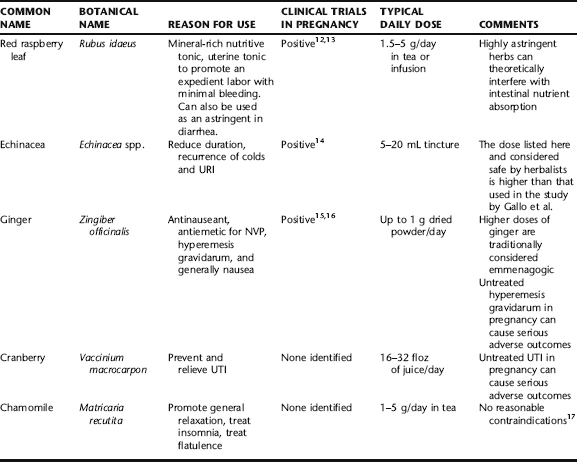CHAPTER 13 Pregnancy: First Trimester
The state of a woman’s health is indeed completely tied up with the culture in which she lives and her position in it, as well as in the way she lives her life as an individual. We cannot hope to reclaim our bodily wisdom and inherent ability to create health without first understanding the influence of our society on how we think and care for our bodies.1
PREGNANCY CARE AND PRENATAL WELLNESS
The past decades have tremendously improved the outcomes of high-risk pregnancies and birth, yet with these improvements have come the ubiquitous presence of technological intervention in nearly all aspects of normal childbearing as well. Yet, the safety and efficacy of the routine use of many interventions is not clear, with a striking lack of an evidence base for many.2,3 Nonetheless, the number and frequency of interventions has risen steadily since the 1950s. Since 2003, cesarean section has been the most common hospital surgical procedure performed in the United States, with 1.2 million of these major abdominal surgeries each year, accounting for more than 25% of all US births at a national cost $14.6 billion in total charges. In spite of spending more money and using more technologies on obstetric care than any other country in the world, the United States ranks only 25th in birth outcome and infant mortality worldwide. Dr. Marsden Wagner, former Director of the World Health Organization’s (WHO) European Regional Office, remarked at an international medical conference that hospital births “endanger mothers and babies—primarily because of the impersonal procedures and overuse of technology and drugs.”4
The desire to avoid excessive technology and an inclination toward natural approaches to health, combined with many women’s perceptions that obstetric care is grossly impersonal, has led women to seek alternatives to conventional obstetric care. Homebirth has become an increasingly popular option because of its astounding safety record and the intimate prenatal, birth, and postnatal care experience it offers women. 5 6 7 8 9 Many choose to self-medicate with alternative therapies, such as herbs, and turn to sources that may not be reliable for information. Although the treatment of common pregnancy complaints with gentle herbs and simple home remedies has generally proved safe, women are increasingly seeking advice through the Internet, books, and alternative practitioners for potentially serious problems than can arise during the childbearing cycle. Thus, it is essential for practitioners to become knowledgeable about natural therapies and willing to have an open dialog with their clients about their concerns and preferences in order to help pregnant women access intelligent and accurate information about the safety and efficacy of such therapies during the childbearing cycle, and to avoid harmful therapies and obtain appropriate medical care as needed.
DIET, NUTRITION, EXERCISE, LIFESTYLE AND PSYCHOEMOTIONAL HEALTH: CENTRAL TO OPTIMAL CHILDBEARING HEALTH
HERBS AS PART OF PREGNANCY WELLNESS
Schools of thought differ on whether herbs should be used routinely—or at all—during pregnancy. Some ascribe to the belief that because most herbs have not been proven safe for use during pregnancy, they should be entirely avoided, whereas others see certain herbs more as foods that can provide an additional source of nutrition during pregnancy, or as tonics that can encourage and support optimal pregnancy health and uterine function.10,11 Many consider the choice of whether herbs are appropriate for use during pregnancy to be circumstantial, for example, dependent upon the nature of the condition being treated and the risk benefit of herbs compared with medical intervention for that particular condition. Certain conditions are beyond the scope of herbal treatment, and practitioners should be keenly aware of the symptoms that herald such conditions and indicate the absolute need for medical care (Box 13-1).
It can be useful to see herbs on a continuum between food and medicine. There are many herbs whose constituents are mostly benign, nutritive substances such as carbohydrates vitamins, and minerals (Table 13-1). 12 13 14 15 16 17 Herbs such as nettles (Urtica dioica), milky oats (Avena sativa), and red raspberry leaf (Rubus idaeus) are examples. On the other hand, there are numerous herbs whose use in pregnancy is entirely contraindicated for safety reasons (see Chapter 12). Somewhere between these categories are herbs not appropriate for daily, routine intake, but which can be used if necessary for brief or more extended periods of time for specific conditions. In addition to common complaints of pregnancy, pregnant and lactating women are also subject to the run of the mill complaints and illnesses we all face—colds, indigestion, headache, etc.—for which they may seek herbal care. Many of these problems can be addressed safely and gently with the herbs listed in the following or discussed in subsections of this chapter.
Table 13-1 provides an overview of a number of herbs that are generally considered safe for general use during pregnancy, reasons for use, and dose. The remainder of this chapter is dedicated to common pregnancy complaints and problems, and the herbs that are often used in their treatment.
THE ROLE OF HERBS IN THE PREVENTION AND TREATMENT OF MISCARRIAGE
Miscarriage, medically referred to as spontaneous abortion (SAb), is the spontaneous, unexpected, and often unexplained loss of a pregnancy before 20 weeks gestation. Miscarriage is the most common pregnancy complication; however, the exact incidence is unknown because the actual incidence of conception in the population is uncertain. One in seven clinically recognized pregnancies will miscarry, and in studies of women attempting to conceive, spontaneous abortion occurs in 10% to 15% of conceptions. 18 19 20 Based on studies of pregnancies achieved through assisted reproductive technologies, 50% of conceptions result in miscarriage. Miscarriage rate is related to maternal age, with rates under 2% for women under 30 years of age, and between 5% and 10% for women more than 40 years old. Miscarriage rates decline to less than 3% if there is a healthy fetus present at 8 weeks gestation (as visible upon ultrasonogram) in healthy women. Note: The term fetus is used throughout this chapter; however, the term embryo is the technically correct developmental term for any baby less than or equal to 8 weeks of gestation.
SIGNS AND SYMPTOMS OF MISCARRIAGE
Signs and symptoms of miscarriage include:
DIFFERENTIAL DIAGNOSIS
Bleeding in early pregnancy can be a sign of serious problems. Major causes of early pregnancy bleeding, other than miscarriage, that must be ruled out include ectopic pregnancy and cervical, vaginal, or uterine pathology (e.g., trauma, polyp, cervicitis, or neoplasia). Molar pregnancy (hydatidiform mole) also should be ruled out. Some women experience a small amount of bleeding on implantation, known as physiologic bleeding, which typically is not of concern.
CATEGORIES OF MISCARRIAGE
CONVENTIONAL TREATMENT APPROACHES
Conventional treatment of inevitable miscarriage includes hospital admission for pain medication if needed, and ultrasound to determine whether the fetus is alive or whether miscarriage is incomplete. In incomplete abortion where there has been substantial blood loss, appropriate emergency procedures are followed, including resuscitation if needed, administration of intravenous fluids, blood work, and treatment of shock and infection is present. A dilatation and evacuation is performed to empty the uterus of any remaining products of conception and medication for pain and infection prophylaxis is administered as appropriate. In cases of missed abortion, typically first identified during routine ultrasound examination, or attention to a discrepancy between maternal growth or subjective or objective pregnancy signs and time elapsed since the missed period, a wait and see attitude may be adopted for up to several days to 2 weeks (depending upon the time elapsed since the missed abortion first occurred) to see if completion of the abortion ensues spontaneously, or surgical removal of the conception products may be scheduled to prevent the risk of hemorrhage and infection.
BOTANICAL TREATMENT FOR MISCARRIAGE: THREATENED AND HABITUAL
This section provides botanical strategies for miscarriage prevention in the event of threatened miscarriage (Table 13-2), and basic support for habitual abortion when resulting from progesterone insufficiency. If fetal demise has been confirmed by ultrasound, readers may follow the protocol in the example in the case history at the end of the chapter. When there is incomplete or missed abortion, special attention needs to be given to the risk of infection and subsequent coagulopathy. Women who miscarry are at some increased risk for postmiscarriage anxiety and depression. Emotional support during and after a miscarriage, as well as during a subsequent pregnancy, is often necessary. Botanical treatments for postpartum depression (see Chapter 18) can be extrapolated for use when needed.
TABLE 13-2 Botanical Treatment Strategies for Miscarriage Prevention in the Event of Threatened Miscarriage and Habitual Abortion

Herbalist/Midwife Protocol for Habitual Miscarriage
| Chaste berry | (Vitex agnus castus) | 50 mL |
| Cramp bark | (Viburnum opulus) | 30 mL |
| Partridge berry | (Mitchella repens) | 20 mL |
| Total: 100 mL | ||
Herbalist/Midwife Protocol for Threatened Miscarriage with Cramping as the Primary Symptom
| Cramp bark * (Viburnum opulus) | 70 mL |
| Wild yam (Dioscorea villosa) | 30 mL |
| Total: 100 mL |
* Black haw (Viburnum prunifolium) may be used interchangeably with cramp bark.
miscarriage prevention with uterine irritability and progesterone insufficiency, which is treated with long-term use of chaste berry (Vitex agnus-castus) begun several months prior to conception and continued until several weeks past the time of prior miscarriage, and accompanied by cramp bark or black haw, and wild yam once pregnancy is established to prevent cramping. Uterine tonic herbs, particularly partridge berry (Mitchella repens) and false unicorn root (Chamaelirium luteum), are commonly included in formulae as well. False unicorn is an endangered herb, therefore, it is recommended to use only cultivated sources. Traditional Chinese medicine can play an important role in miscarriage prevention when there is habitual abortion, as its constitutional diagnostic model and corresponding herbal and dietary protocol can be specifically tailored to a woman’s constitution and imbalances.
In case of threatened miscarriage, the Western herbal practitioner will need to address commonly overlooked factors, such as overwhelming stress, dehydration, or malnutrition. Urinary tract infection (or other infection) should be ruled out, and if present, treated (see Chapter 10). Women should attempt to achieve an optimal body weight prior to conception with underweight women, particularly trying to bring their weight to within a normal body mass index to ensure adequate hormone production. Herbs can be used primarily to reduce uterine contractions associated with threatened miscarriage. The most commonly used herbs include cramp bark (Fig. 13-1), black haw, and wild yam, either alone or in combination.
Black Haw, Cramp Bark, and Wild Yam
When there is uterine cramping in the absence of cervical dilatation, cramp bark (Viburnum opulus) and black haw (Viburnum prunifolium) are used to arrest uterine spasm.49,50 These herbs, which can be used interchangeably or together for this purpose, have a long history of use as spasmolytics during pregnancy, especially for miscarriage, dating back well over a hundred years by Western herbalists, and even longer by Native American tribes.49,50 Black haw was official in the United States Pharmacopoeia in 1882, its uses as an antispasmodic and preventative for miscarriage popularized by the Eclectic physicians. Cramp bark is included in the British Herbal Pharmacopoeia and is used by herbalists in the United Kingdom for miscarriage prevention.17,49 The active principles are unknown; however, it is thought that at least four active substances, including scopoletin and aesculetin, which have been identified, have uterine spasmolytic activity.51
Another herb with a long history of use for relieving uterine contractions is wild yam (Dioscorea villosa). Although this herb has developed the erroneous reputation for use as a progesterone supplement, wild yam in fact contains no progesterone, nor can it be converted by the body into progestogenic substances. However, this does not preclude its efficacy and reliability as a uterine antispasmodic, combining well both cramp bark and black haw; although, no research was identified that either supports or refutes its traditional uses.17
Stay updated, free articles. Join our Telegram channel

Full access? Get Clinical Tree




